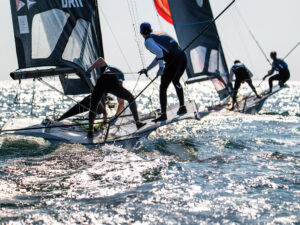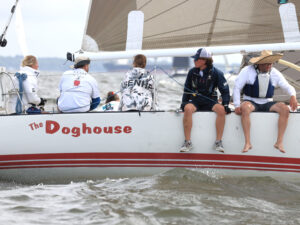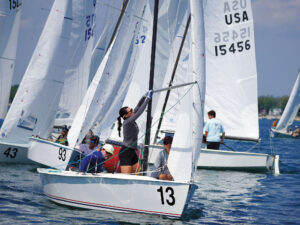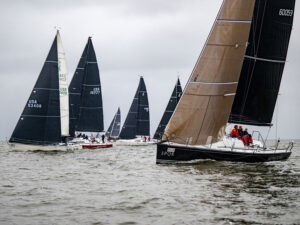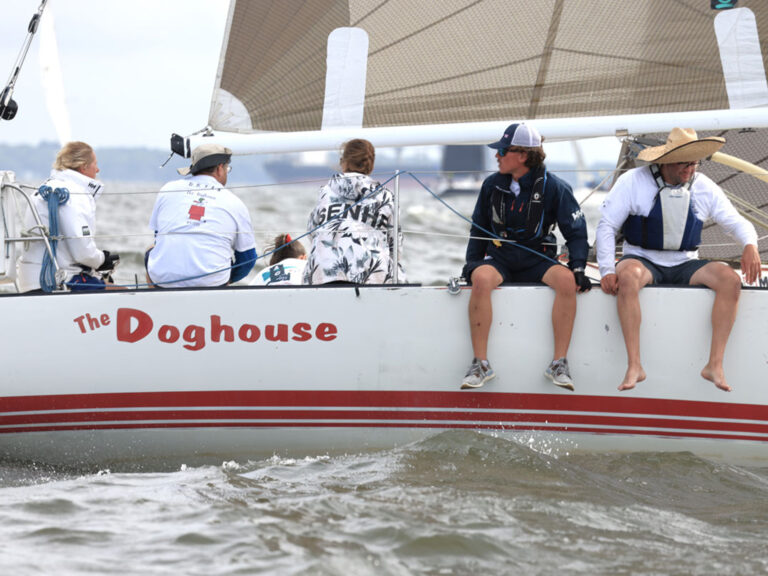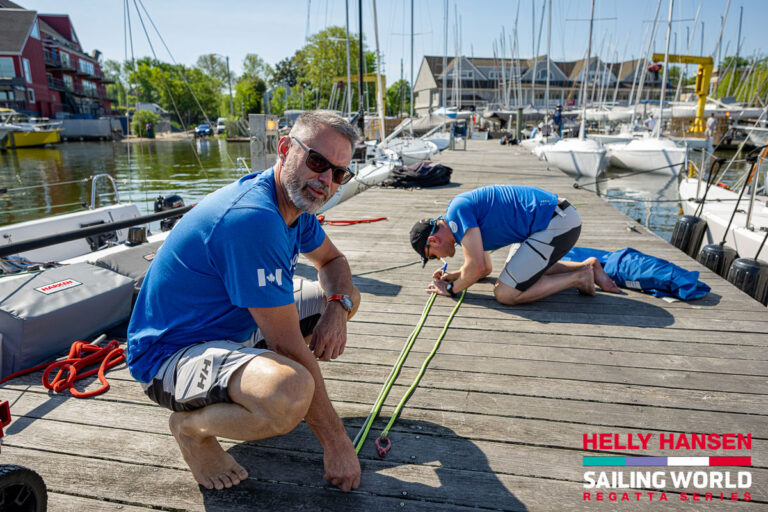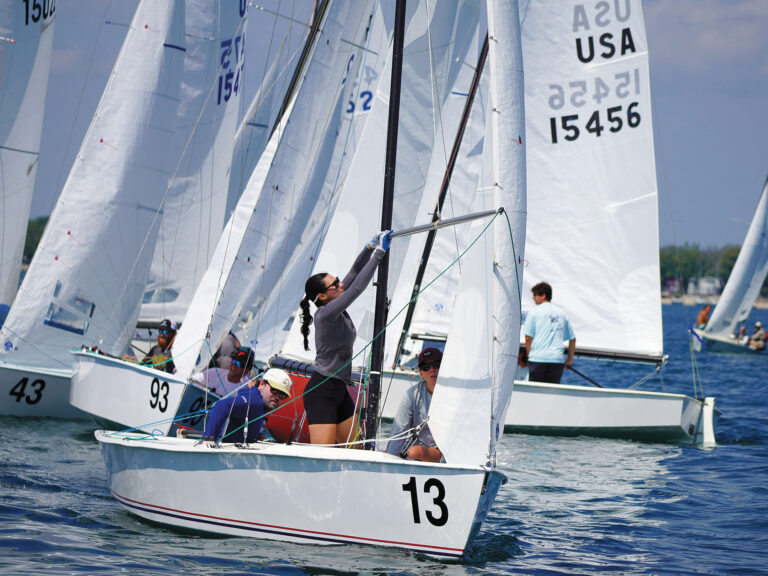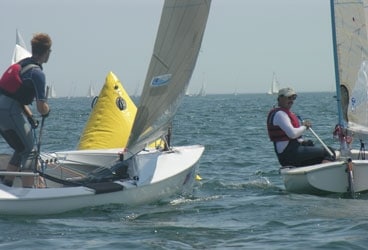
Protests are no fun and your chances aren’t that great, so think twice before trying to exert your rights and you may be happier for it. From our July/August 2007 issue.
The contrast on opposite sides of the parking lot is striking. On the north end are four small, white tents set up to handle Acura Key West Race Week’s protest hearings. One tent was for handling arbitration sessions. This is where you’re given one last chance to cut your losses and take a penalty before finding yourself in one of the other three tents reserved for intense, and often heated protest hearings. Lined up in orderly fashion outside the tents are two dozen chairs set up for the sailors waiting in line to present their cases. It’s a solemn scene; faces are tight. It’s all business.Across the parking lot, to the south, stands an immense circus tent with 2,000 festive sailors swapping tales of the day’s racing. There’s raucous music, videos, and the heavy din of chatter. There’s no question which side of the parking lot is having more fun.Unfortunately, protests are an integral part of racing, and this scene is all too common, especially at Key West Race Week where 260 highly competitive boats push hard to win races. The sailing is usually aggressive; collisions, close encounters. Bruised feelings are an unfortunate byproduct, as are trips to the protest room.The best advice anyone can offer may seem trite, but it’s true: if you want to enjoy your regatta, stay out of the protest room at all costs. Fifty percent odds are not favorable, nor conducive to a winning scoreline. Out on the racecourse this means sailing with a bit of tolerance or not pushing too hard to gain an advantage. For many sailors this goes against their natural instinct to seek confrontation. You can see it everyday on our roadways: aggressive drivers tailgate or weave in and out of lanes, cutting off others at will. The result of such intensity sometimes results in far more serious litigation than a sailing protest, but this same mean spirited attitude is what starts the spiral of problems.The best sailors who have a clear understanding of the Racing Rules of Sailing know when to exert their rights and when to back off. Recognizing the skill level of other competitors often determines how hard a veteran pushes a tactical situation. A pro will usually give some extra room to the less experienced-after all, the 50 percent rule of the protest room applies to everyone.It’s clear that avoiding the protest process is the preferred course of action. Nevertheless, sailors do end up in protests for legitimate reasons. To understand what goes on in the protest room at Key West I audited several of the 35 hearings. The process was enlightening to say the least.My first sit-in was an arbitration panel session hosted by veteran international judges Arthur Wullschleger and Leggie Mertz. The opposing skippers presented their cases regarding a buoy room situation at a leeward gate. As you’d expect, neither side would admit wrongdoing-otherwise they’d be under the tent with their mates. At this point, one boat could have admitted the error of his ways and taken a 40-percent penalty. Wullschleger was visibly bothered that one boat would not accept a penalty-so off they went to wait their turn for a formal hearing. I waited within earshot. Witnesses were lined up, the rules discussed among the individual parties, and finally there was silence. Both skippers sat several chairs apart with their arms folded across their chests. You could feel the tension rising. The wait made it worse.About 30 minutes passed when Dick Kempe, an international judge from Bermuda, called the two skippers into the tent. I went along to listen. Two intensely determined skippers represented the infringing 34-footers, which I’ll refer to as Tiger and Lion. The atmosphere inside that tent was thick-there was the undeniable sense that someone was going to walk out with a disqualification in hand and a chip on his shoulder. Kempe, along with two other jurors-Egil Wold, of Norway, and Tom Rinda, of the United States, presided over the hearing.The scene was businesslike. Kempe went through the mechanics of the hearing, including making sure a protest flag was actually flown and a hail made. The protestee said they saw a flag flown, but did not hear the hail, “Protest.” The hearing proceeded anyway. Here’s how the facts were presented: Tiger and Lion approached each other on opposite jibes toward the leeward gate, to be rounded to starboard. Tiger jibed inside Lion. But Lion refused to give room, claiming the overlap was attained inside the two-boat circle at the mark. Tiger avoided a collision by turning away before the mark and circling back around. Tiger lost considerable distance in the messy process and believed they were entitled to buoy room. There was no contact made between the boats. The question in this situation was whether Tiger was entitled to room. Lion believed an overlapped was established too late.Judge Kempe then questioned them on issues related to time, distance, and speed. Lion stated that Tiger jibed 18 to 20 seconds before rounding the mark. Both parties agreed they were sailing at about 5 knots approaching the mark.Both skippers then called witnesses into the room. It was clear the incident on the water was not friendly: one witness said in an animated way, “We were shocked you didn’t give us room!” The jury looked stern, but remained quiet during the tense exchanges between the skippers and their witnesses. At this point I was ready to walk across the parking lot to the party tent, but I wanted to hear the outcome.The witness for Lion stated that the jibe occurred three to four boatlengths from the buoy. This fit with the 18- to 20-second time frame that all four sailors agreed upon. There was also ample time during the incident for both boats to drop their spinnakers.This was a key turning point during the protest hearing. Kempe, Wold, and Rinda asked the witness from Lion where he was sitting in the boat and in what direction he was facing? The answer clinched a protest-room victory for Tiger. The witness said he was in the middle of the boat facing forward and easing the spinnaker halyard. He glanced to windward, noting that the other boat was abeam. After excusing the sailors the three judges reviewed the testimony using the time and distance discussion to determine that Tiger was overlapped and entitled to buoy room and disqualified Lion. The review only took 2 minutes and the decision was unanimous. The skippers were called back in and the verdict read. Lion’s kipper wanted to debate the finding, but Kempe took the time to explain that the time of 18 to 20 seconds at 5 knots had the boats overlapped well before they entered the two-boatlength circle. Lion’s skipper was noticeably unsatisfied with the outcome, but I later saw him at the tent and his troubles seemed to be disappearing.There are several lessons to be learned from this protest hearing:1. It is best to avoid a protest situation on the water. It ruins the post-race activities and no one comes away feeling good.2. Read the body language and accept the suggestions of the arbitrators. In this case a 40-percent penalty against Lion would’ve been better than a disqualification.3. If you do get involved with a protest hearing, make a graph of a boat’s actions so you can determine accurate time and distance. It seemed to me that Lion’s skipper lost track of time during the confrontation, his boat’s spinnaker drop and the rounding.4. Listen carefully to the testimony of the other party and the witness. Lion’s skipper seemed to not listen very well, missing the point that his 34-foot boat sailed more than two boatlengths in 18 to 20 seconds.5. Avoid a post-protest argument. It never plays well with a jury. If you’re found at fault, make a peace offering and offer to buy the other party a beer (or in Key West, at least stand in line for him or her). A little goodwill might go a long way the next time you two meet at a leeward mark.Peter Craig, Race Chairman of Acura Key West Race Week, says that over the last five years there has been a dramatic decrease in the number of protests. “It wasn’t three or four years ago that we would have over 100 protests lodged during the course of the week whereas during this past January there were less than 35,” he says. “The remarkable fact is that you have 17 classes racing nine races and a total of 260 boats. That’s an outstanding statistic to have only 35 protests with far fewer heard.”The following day, I returned to the protest area to see what was brewing, and noted that none of the previous day’s participants were there-no surprise there. A new group was waiting their turn, and I bet they, too, eventually learned that spending an afternoon in “the room” is no way to have fun in Key West.

